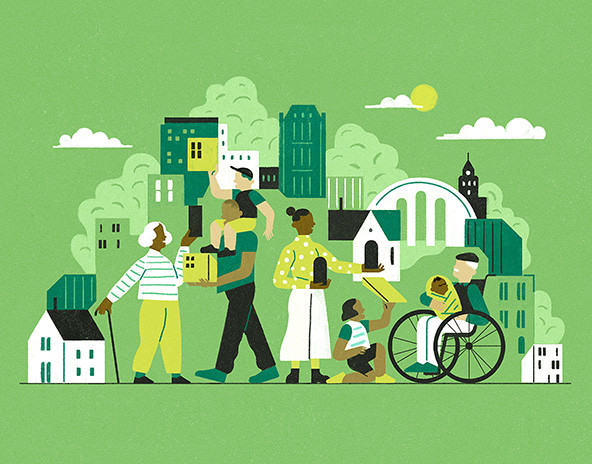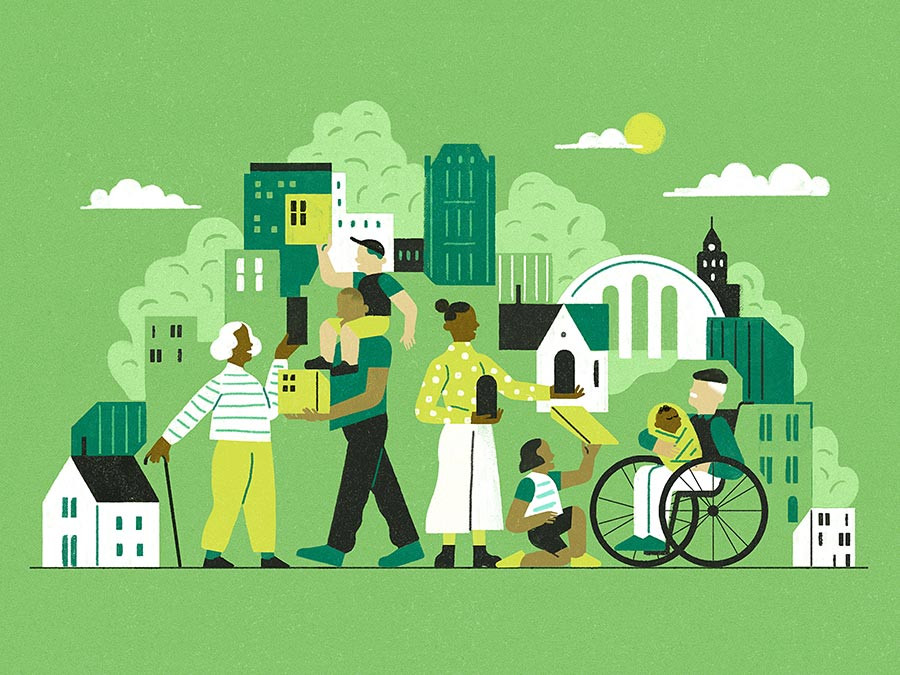 (Illustration by Gracia Lam)
(Illustration by Gracia Lam)
This essay series, “Meeting the Multigenerational Moment,” exposes a generational divide in American society that’s complex and deepening. As the opening essay explains, the United States began the 20th century as one of the most age-integrated societies in the world and, through a series of well-meaning social innovations including universal education and nursing homes, ended it as one of the most age-segregated. Today, most younger people are in school, middle-age people are at work, and older people are in age-restricted communities; their lives rarely intersect.
This restructuring has left the country ill-prepared for a world with more Americans living longer lives and more generations living at the same time. Collectively, we face a range of social problems, including wasted human resources, generational tension and rampant ageism, an epidemic of loneliness, and splintered movements for social change. Individually, we’re left without the proverbial village, making it harder to raise children and support caregivers, understand the challenges other generations face, find mentors at work and role models in life, and collaborate across divides to solve problems such as racial justice and climate change.

But while it’s true that social innovation helped get us into this mess, we believe it can help us find our way out. The other essays in this series provide considerable reason for optimism, telling the stories of talented social innovators crafting intergenerational solutions to a wide-ranging array of problems.
Generation XChange, for example, is rethinking the makeup of schools to include older adults. The University of Minnesota’s Advanced Career Initiative is doing the same in a higher education setting. Nesterly and New York University are bringing the sharing economy to housing, and Bridge Meadows is rethinking foster care by creating a new kind of multigenerational living experience. Mon Ami is showing how the two loneliest populations can connect and forge deep bonds through home visits. And throughout America, senior centers and preschools are co-locating in ways that bring mutual benefit to elders and young people alike.
Yet for all the compelling examples, these efforts are far too small. The picture of intergenerational innovation that emerges can seem utopian—uplifting but hardly transformational. Not enough innovators are reaching for intergenerational strategies, and too few of those who are have achieved any kind of scale. Funding is small and scattershot. Policies to facilitate intergenerational solutions tend to be non-existent, but restrictive rules often are part of the problem, making it harder for older and younger populations to get together.
If social innovation is going to help deliver us from a state of what Andrew Scott, author of The Hundred-Year Life, calls “age-apartheid,” it will need to subsist on more than creativity, pluck, and promise. In this concluding essay, we reflect on four ingredients necessary for making innovative, intergenerational strategies a part of every solution.
1. A New Mindset
For too long, the idea of bringing older and younger people together has started—and stopped—with a single intergenerational activity or program. How many of us were part of a youth group, scouting troop, or service club that visited a nursing home once a year to drop off Valentine’s Day cards or sing Christmas carols?
To catalyze large-scale change, we need to move on from starting points and establish routine, embedded ways of doing business—and living life. In the realm of environmental sustainability, for example, this may mean the difference between a company launching an optional recycling program and developing an organizational-wide commitment to “go green.” It means a shift from “nice to have” options to a collective responsibility (and benefit) that people can’t ignore.
Individuals and organizations can begin to make an intergenerational shift by committing to a new mindset—an asset-based lens that combats ageism and leverages the complementary aspirations, gifts, and contributions of old and young. As series contributor Brittany Koteles notes, the intergenerational community Nuns and Nones got its start when a group of spiritually minded millennials figured they had a lot to learn about contemplative living and social justice from Catholic nuns after a single meeting with them. At the same time, the nuns saw in these young people a future for their way of life.
In San Jose, California, Mayor Sam Liccardo saw the assets of older people in his city as a way to give its younger residents a stronger start. To make it happen, the city practiced what it preached, hiring a group of Encore Fellows—retired professionals from the corporate sector eager to start a second career that benefitted the greater good. Most recently, as one series essay notes, an Encore Fellow helped the city launch a mentoring program in which older adults match underserved youth with young professionals for career conversations.
We need more of these stories and more depictions of intergenerational connection in popular culture (think the years’-long musical collaboration between Lady Gaga and Tony Bennett, or the recent Oscar-nominated movies Minari with Yuh-Jung Youn and The Life Ahead with Sophia Loren) to shift mindsets and spur people to behave differently.
2. More Money
Social innovators bringing older and younger people together to solve multiple problems often find themselves in a no-man’s land when it comes to funding. Their work intentionally crosses boundaries, making funding streams intended to help a single population or solve a single problem an awkward fit at best.
Determined to break down age-based silos in philanthropy, Trent Stamp and Cathy Choi at The Eisner Foundation came up with a new approach. “We decided that separately funding charities for children and older adults was limited and outdated,” they write. “A new intergenerational focus would allow us to more effectively improve the lives of both older and young populations, and communities as a whole.” Today The Eisner Foundation is the only US foundation that funds solely intergenerational programs, providing $8 million each year “to support concrete opportunities for each generation to benefit from what the other has to offer.”
Others should follow its lead. Foundations with one portfolio for aging and another for children and youth could test Eisner’s “every dollar spent twice” concept simply by designating a portion of funds from each portfolio to new grantees with an intergenerational focus. Or they could follow the example of The Deerbrook Charitable Trust, which embedded language in its request-for-proposal process prioritizing youth-serving organizations that include the skills and life experiences of people age 50-plus as part of their solution. Funders in the field of aging could likewise give priority to proposals that intentionally engage youth as part of the solution.
Another option is to take a page from the New Pluralists’ playbook. This recently formed grantmaking collaborative aims to pool $100 million over 10 years to support efforts that bring people together. A group of bold philanthropists could similarly pool their funding to support collaborative efforts between intergenerational field builders.
3. A Supportive Policy Environment
Intergenerational funding strategies can breathe new life into the field, but for social innovations to take root in everyday life and achieve scale, we need policies that incentivize intergenerational connection.
Problems in the policy arena are common and long-standing. For example, 60-year-old policies stand in the way of national service models that could bring older and younger people together to serve their communities, bridging divides and bringing the unique talents of each age group to the task at hand. Instead, as our colleagues Marc Freedman and Phyllis Segal write, service efforts have been explicitly organized by age. The result: “essentially parallel programs—AmeriCorps largely enrolling young people, Senior Corps (now AmeriCorps Seniors) entirely recruiting older ones.”
Managers of shared sites that bring childcare and eldercare under the same roof “often struggle to navigate age-segregated licensing and accreditation rules,” as Donna Butts and Shannon E. Jarrott explain in their essay. At one shared site in Arizona, childcare regulations prohibited children from interacting with older adults inside the childcare center. To get around the rule, the site built a separate room with a different address so that children could go on “field trips” to visit the elders.
Policy changes, large and small, can nudge—maybe even shove—the field forward. California’s Master Plan for Aging, which explicitly calls for intergenerational volunteerism and the co-location of activities and services for old and young together, is a good start and a model for others to follow.
4. A Research Agenda
Innovators piloting new intergenerational models need research that can drive improvements in practice, and help make the case for expansion and investment. Generation Xchange, a partnership between the Los Angeles Unified School District and UCLA’s Department of Geriatrics, engages volunteers over age 50 as tutors and mentors to elementary school students in South Los Angeles, benefiting both groups. Data tells the story in this essay: “In one school, the percentage of first graders who met reading standards nearly doubled, jumping from 38 percent to 77 percent in the first two years of the program. Meanwhile, volunteers have seen real health benefits, including lower blood pressure and cholesterol levels, desirable weight loss, and faster walking speeds.”
Research on the impact of a single program can influence investment in that program. But data on the impact of intergenerational connection, or the lack of it, can influence the growth of the entire field.
Take the issue of loneliness. Data on the negative health consequences of loneliness in US culture and workplaces—equivalent to the impact of smoking 15 cigarettes a day—reframed the issue as a public health crisis. That influenced social innovators, like Joy Zhang and Madeline Dangerfield-Cha, who started the home-sharing platform Mon Ami. It also influenced funders to back their idea, and city governments to use the platform to match isolated older adults with young people who could help them during the pandemic. And it influenced dozens of other start-ups—including the volunteer-driven Big & Mini and Papa, which recently raised $60 million for its program to pair adults with younger, paid “papa pals” who ease loneliness and help with tasks.
Compelling research on the impact of intergenerational connection—at school and work, and in communities—can build an ecosystem of innovators, policy makers, and philanthropists dedicated to well-being, connection, and intergenerational strategies.
Imagine a Different Future
These ideas could help realize something that’s more than the sum of its parts: a modern-day village, a kampong for all ages. And we don’t have to imagine that anew: Something close to that vision is still alive and well in many Indigenous cultures, immigrant communities, and communities of color, although even they face the corrosive impact of age segregation.
We must learn from proven intergenerational traditions and practices, and remix them for modern times, creating a vibrant new social contract that reflects the multigenerational and multicultural reality that is already reshaping the American landscape, and that will be a hallmark of the 21st century. A new social contract built around the idea of interdependence and generational solidarity. One that makes respect and dignity for all people regardless of age, race, or background a centerpiece. And one that is rooted in a sense of the wholeness of life, recognizing that aging is the one thing we all truly have in common.
Indeed, a commitment to co-generating a better future can play a huge role in getting us out of the mess we’re in—as manifested in ageism, loneliness, and generational conflict. Everyone benefits when we tap the assets of old and young people to bridge divides and solve problems. By committing to new mindsets, investment, supportive policy making, and research development, social innovators can help make the most of this multigenerational moment.
Support SSIR’s coverage of cross-sector solutions to global challenges.
Help us further the reach of innovative ideas. Donate today.
Read more stories by Marci Alboher & Eunice Lin Nichols.

